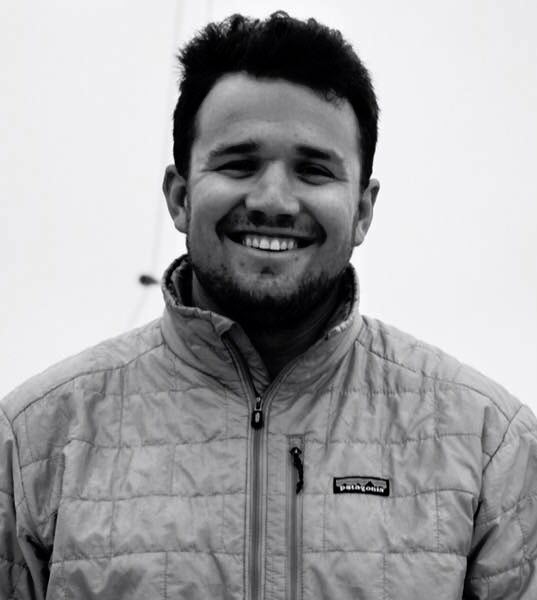Helping move young sailors forward
Published on January 9th, 2018
Finn Hadlock was just 24 years old when he led his young team from Maine to compete in the 2017 J/24 World Championship in Toronto, Canada. There were many steps between when he first bought the boat to fulfilling this goal, and has provided this report in hopes that other young adults looking to start their own team can learn from his two year odyssey.
There were many factors that initially led to buying a J/24. The first was that there was a local fleet in Portsmouth, New Hampshire. Although not a very large fleet, at anywhere from 9 to 13 boats, the local “Knucklehead” fleet seemed perfect. The second draw was the high level of racing at a local level.
The J/24 class is still one of, if not the most, competitive one design classes in the New England area. With over 5,100 boats built, the J/24 has a long history of being a great one-design keelboat. Lastly, J/24s are a great value. I went through about every forum and listings page I could find and there were a lot of great boats in the $4,000 to $10,000 range.
My first big break was buying a $5,000 boat from a guy named Joe. Throughout this search process, I knew I needed a boat that was race ready, had a good trailer, and a measurement certificate. You will see the term “Race Ready” on many boat listings. I think the easiest way to validate this is to simply research how much racing the boat has done.
The boat I bought, Boreas, had a good track record and documentation from Waterline Systems of a bottom and keel job. In addition, she had relatively new winches, a Tacktick compass, carbon pole, and a very decent set of sails. These all would have made retrofitting a slightly less expensive boat more expensive.
After I bought the boat there were many things I would have liked to upgrade, but financially just buying the boat was a big stretch at the time. I was just starting to figure out all the expenses involved – joining the local fleet, registering the boat, get a mooring, having a dinghy slip, etc. Things were adding up in a hurry.
With bills mounting, this was when I decided to end my housing lease and live on my J/24. This sounds crazy, and it was, but after exhausting every resource I had in the area, I ended up on a mooring for free. I then joined a local yacht club as suggested by a longtime friend Vince. It was a great deal because I could join and have my small inflatable tied up for $500. Most importantly, the club had a shower.
Living on a J/24 is a lot like camping. There isn’t space for anything and it’s relatively damp. I had a small assortment of cooking essentials, a boom tent, and a well-stocked cooler. In order to save hauling everything to and from the boat, I bought plastic drawers for the back of my car to hold my clothes.
To be competitive for local fleet racing I would pack everything in two plastic bins and put them into the dinghy to reduce weight. For those three months, I had the best commute to work anyone could ask for. Although it felt a little tight at times, I would highly suggest it.
A huge resource was my dad, Parker, who owned and raced J/24s back in the 1980s. Although a lot has changed on the boat, having someone who could feel the boat and know the roles of the team helped immensely. The other set of eyes helping was a GoPro mounted on the stern.
That summer I filmed every race and then watched it the following night to note how we could get better. I would freeze the video, look at my heel, sail trim, and look up the tensioning from my log and compare it to the tuning guide to see what we needed to change.
Speed is king in the J/24 class, and most of the major controls are controlled by the skipper when going up wind. Reading, watching videos, and getting help from people who know the boat helped us improve every time we went out on the water. I became addicted to the process of becoming faster.
At our first regatta, we expected some challenges…but nothing quite like your jib trimmer getting kidney stones the first morning. We saw every end of the fleet at the Downeast Regatta but came out knowing we could compete. We also got to meet Molly and Carter White. Molly told me about the youth team (under 25) bid for the 2017 Toronto World Championship.
Like many other one design classes, in order to go the J/24 Worlds you have to qualify through different events or be accepted based on previous results, and two of these spots were reserved for youth teams. The goal of making it to Toronto for Worlds was set into motion after we had a successful event at the Changing of the Colors Regatta.
We ended up in third place in a relatively competitive fleet, but more importantly, we had shown ourselves we could improve. The new sails we got from Quantum’s Travis Odenbach certainly helped. We finished the year with a strong last race at the East Coast Championship and sent in our resume to the USA J/24 Class Association for the youth team bid at Worlds. Throughout these events, we got to meet some great people and even developed some fun rivalries with other boats.
I was ecstatic when I found out we were selected as the youth team for Worlds, but I also recognized we had a long way to go before we’d be ready. The backbone of our team was two Yarmouth High School students – Griffin (17) trimming the spinnaker and Anna (18) on the bow – though we had no twing or jib trimmer locked in. To add another challenge to the mix, I was relocated to Houston, Texas, for work.
Luckily, I had the opportunity to sail with Carter White’s team in Houston for a weekend regatta. Having only skippered the boat up to that point, I had not been able to focus on the other positions on the boat. Carter is extremely good at simplifying the systems on the boat. I had been following the tuning guide and feeling my way through each individual situation. Coming out of that event, I realized in order to continue to get better, I needed to be more systematic in my approach.
Being more systematic applied off the water too. When I asked someone to sail with me, I feel it is important to be upfront about my expectations. I’d provide lunch on the water (most likely PB&Js) and sleeping arrangements. I also like to take everyone out for a team dinner on one of the first nights of the event. Most importantly, I would send my team our schedule and two or three goals for the event.
After arriving to the Sail Newport Regatta with my lifting bar forgotten back in Texas, we became more systematic in our rigging and derigging of the boat. Creating a set place for everything to go, including tools, reduces stress and helps speed up the packing process. We’re definitely still working on this organization, but it is significantly better compared to when we were in Newport.
Everything started coming together quickly at the Downeast Regatta, a week before Worlds. Our team was topped off with two very experienced J/24 sailors named Matt (23) and Emmet (22). Matt was brought on board through our mutual connection, Molly White. Emmet was an old family friend and foe from racing in Portsmouth. This experience helped us immensely. We finished the regatta in 3rd place, and were one of the fastest boats all weekend.
Finally, we made it to Worlds. The 12 hour drive there was a lot like a long drive to an interview for a job you don’t know you’re qualified for. We certainly did not feel qualified after opening the regatta with 50th place. But, much like the last two years, we learned from our mistakes and relied on the process that got us there. We ended up 28th overall and winning the U-25 Turner Trophy.
I am very grateful for all the help we had to get our program up and running. I know that through the Boat Grant Program, youth bids for Worlds, and a great community of sailors, the J/24 class will continue to help move young sailors forward.
If you have any questions about the Boreas team, please feel free to contact me at WFinnHadlock@gmail.com.
You can continue to follow our racing on Instagram: Boreas_USA2736
or at www.facebook.com/BoreasUSA2736
Also, if you’re interested in applying for the boat grant: http://J/24usa.com/boat-grant-program/












 We’ll keep your information safe.
We’ll keep your information safe.